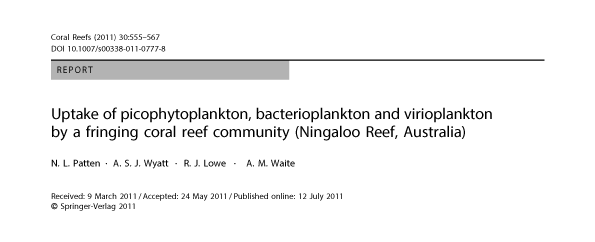Uptake of picophytoplankton, bacterioplankton and virioplankton by a fringing coral reef community (Ningaloo Reef, Australia)
Nicole L. Patten, Alex S.J. Wyatt, Ryan J. Lowe, Anya M. Waite
We examined the importance of picoplankton and virioplankton to reef trophodynamics at Ningaloo Reef, (north-western Australia), in May and November 2008. Picophytoplankton (Prochlorococcus,Synechococcus and picoeukaryotes), bacterioplankton (inclusive of bacteria and Archaea), virioplankton and chlorophyll a (Chl a) were measured at five stations following the consistent wave-driven unidirectional mean flow path of seawater across the reef and into the lagoon.Prochlorococcus, Synechococcus, picoeukaryotes and bacterioplankton were depleted to similar levels (~40% on average) over the fore reef, reef crest and reef flat (=‘active reef’), with negligible uptake occurring over the sandy bottom lagoon. Depletion of virioplankton also occurred but to more variable levels. Highest uptake rates, m, of picoplankton occurred over the reef crest, while uptake coefficients, S (independent of cell concentration), were similarly scaled over the reef zones, indicating no preferential uptake of any one group. Collectively, picophytoplankton, bacterioplankton and virioplankton accounted for the uptake of 29 mmol C m−2 day−1, with Synechococcuscontributing the highest proportion of the removed C. Picoplankton and virioplankton accounted for 1–5 mmol N m−2 day−1 of the removed N, with bacterioplankton estimated to be a highly rich source of N. Results indicate the importance of ocean–reef interactions and the dependence of certain reef organisms on picoplanktonic supply for reef-level biogeochemistry processes.
Keywords: Coral reef, Picoplankton, Virus, Uptake, Ningaloo Reef, Indian Ocean

